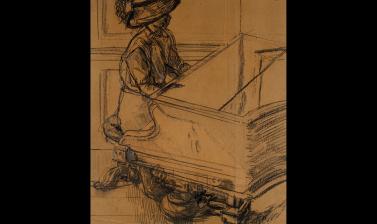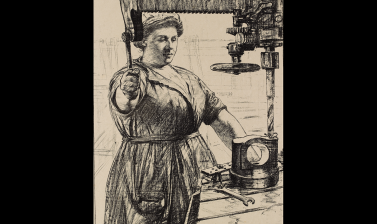THE HOME FRONT: FROM MUSIC TO MUNITIONS

THE HOME FRONT: FROM MUSIC TO MUNITIONS
1. Walter Sickert, Study for 'Tipperary', 1914
The Camden Town artist Walter Sickert (1860–1942) was born in Munich, the son of a Danish-German artist. At the outbreak of war he had to provide evidence to the Home Office that his father had been naturalized to avoid being interned. Too old to be called up, he was an influential teacher between 1915 and 1918 at the Westminster School of Art, where he taught the painter David Bomberg (1890–1957). This is a study for Sickert's painting Tipperary (1914) at Tate Britain in London, which shows a music-hall pianist playing the familiar wartime song 'It's a long way to Tipperary'. Written in 1912 by Jack Judge and Harry Williams, it is often thought of as the archetypal marching tune of World War I, but music was equally important for keeping up the spirits of those left behind at home.
2. Archibald Standish Hartrick, Underground in Wartime, 1916
Henry Moore's studies of civilians sleeping in the London Underground during the Second World War are relatively well-known (for example, Shelterers in the Tube in the Tate), but the Tube was also used as a place of shelter from air raids during the First World War. Archibald Standish Hartrick (1864–1950) sketches a variety of types forced to sit cheek by jowl in the confined space of the Holborn Underground station in this informal and sympathetic lithograph. The standing boy scout to the right provides a lively contrast with the exhausted-looking women surrounded by their sleeping children in the foreground. During the war women were recruited to work in traditionally male jobs on the Underground transport network, as substitute guards, clerks and painters, because of the shortage of manpower. When the new Maida Vale station opened in June 1915, it was staffed entirely by women.
3. Archibald Standish Hartrick, On Munitions: Heavy Work - Drilling a Casting, 1917
Hartrick's series of six lithographs for the Efforts and Ideals series, 'Women's Work', reveals the important roles played by working women during the war, from bus conductors, carriage cleaners and farmhands to workers in heavy industry and the dangerous packing of munitions. The unidealized presentation of this portrait underlines the seriousness with which women approached their new opportunities for employment; the woman is as solid and powerful as the machine she controls. Born in Bangalore, the son of a British Army officer, Hartrick studied art at the Slade School and in Paris, becoming friends with Van Gogh and Toulouse-Lautrec. He is best known as a lithographer, and in 1940 – in an echo of his lithographs for the Efforts and Ideals – he was commissioned by the Ministry of Information to record the work of the Women's Land Army.










